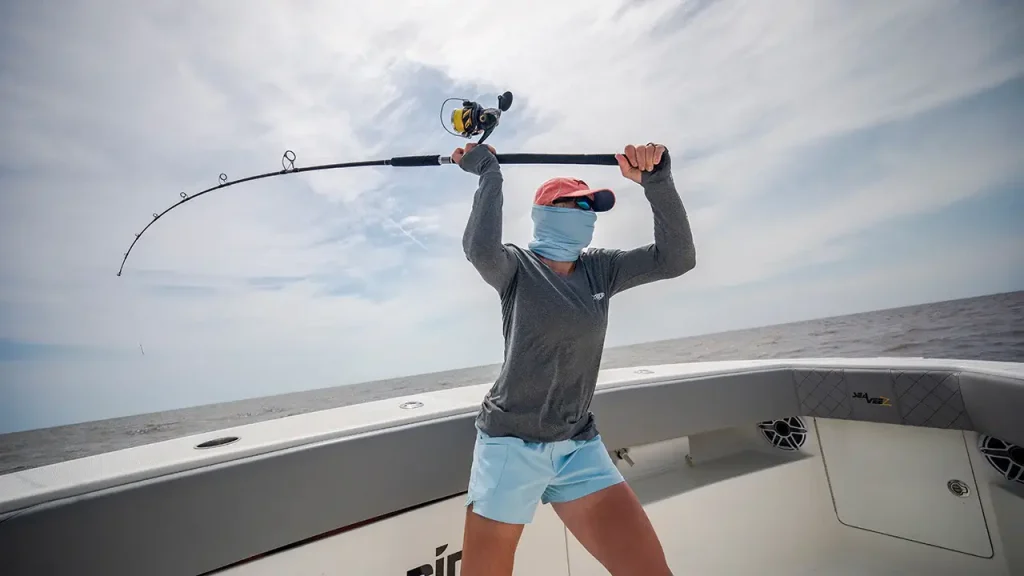Let’s be honest, casting a fishing rod can be intimidating for beginners. I still remember my first time – tangled lines, frustration, and a lure that somehow ended up snagged in a very tall tree (don’t worry, I eventually rescued it… and my dignity… after a fair bit of scrambling). But fear not, fellow fishing enthusiasts! Mastering these 7 expert techniques will transform you from a tangled-line tangle bunny into a confident caster, ready to impress your fellow anglers (or at least avoid frustration and enjoy your day on the water).

Imagine a handshake with your favorite fishing buddy – that’s the kind of grip you want on your rod. A firm but relaxed hold is key. Think about gripping a tennis racket – comfortable, secure, but not white-knuckled. This relaxed grip might seem counterintuitive, but trust me, it allows the rod to flex properly during a cast, generating more power and accuracy. Here are two common grip styles depending on your reel type:
The Baitcasting Grip (for baitcasting reels): Hold the reel snugly in your palm with your thumb resting on the spool. Imagine your other hand giving a high five to the reel seat, with your index finger pointing along the top of the rod blank (the main rod body).
The Spinning Grip (for spinning reels): Cradle the underside of the reel seat with your dominant hand, thumb on top and fingers wrapped comfortably around the grip. Your other hand can rest lower down on the handle for added control.

Think of your reel as your silent partner in crime – well, in this case, the crime is catching a whole lot of fish! While it might seem like a complex piece of machinery at first, understanding a few basic settings can make a world of difference in your casting success.
The Drag: This amazing feature determines how much pressure the line releases when a fish pulls on it. Imagine a tug-of-war – a properly set drag prevents your line from snapping during a fight with a feisty fish, but also allows you to play the catch without putting too much pressure. Consult your reel’s manual for specific adjustments on this one.
The Spool Release: This is the lever or button that frees the spool, allowing you to feed line freely when casting or playing a fish. Mastering smooth spool release is crucial for a controlled cast and avoiding overruns (backlashes – a tangled mess of line on your reel). Imagine a runaway horse – you don’t want your line to be bucking wildly!
Spool Tension: This is the unsung hero of casting! Think of it like a spool of thread – too loose and it unravels everywhere, too tight and it gets stuck. Spool tension controls how freely the line comes off the spool during a cast. A properly adjusted spool tension allows the line to flow smoothly but offers enough resistance to prevent overruns. Most reels have a knob or dial for spool tension adjustment. A good starting point for beginners is a slightly looser setting, which you can gradually tighten as you practice and gain confidence. Don’t be afraid to consult your reel’s manual or ask for help at your local tackle shop if you need further guidance.

You might be surprised, but your body position plays a significant role in casting success. Here’s how to stand tall for powerful and accurate casts:
Core Engagement: Think of casting like throwing a baseball – it all starts from the core. Engage your core muscles for stability and power transfer throughout your body during the cast. Imagine pulling your belly button in towards your spine – this creates a strong foundation for the movement.
Relaxed Shoulders: Tense shoulders are the enemy of a smooth cast. Remember that handshake grip on the rod? Apply the same principle to your shoulders. Keep them relaxed and loose, allowing your arms to move freely throughout the casting motion. Picture yourself casting with a gentle breeze blowing through your hair, not a storm brewing in your shoulders!
The secret to a good cast lies in the power of the pendulum swing. Imagine a pendulum swinging back and forth – that’s the controlled motion you want to replicate with your rod. Here’s how to break it down:
The Back Cast: With the lure dangling freely below the rod tip, raise the rod smoothly back over your head, keeping it pointed slightly lower than a 45-degree angle. This helps avoid snagging your lure on overhead obstacles like branches. Stop the rod tip at a comfortable height – somewhere between your shoulder and ear is a good starting point.
Loading the Rod: As you raise the rod tip in the back cast, feel the weight of the lure begin to load the rod. This bend in the rod blank is what generates power for your forward cast. Imagine the rod bending like a slingshot, storing that energy to propel your lure towards fishy paradise.
The Forward Cast: Now comes the moment of truth! Initiate the forward cast with a smooth, powerful swing of your rod tip, mimicking the motion of the back cast but in the opposite direction. Imagine propelling the lure forward with the bend in the rod, not just your arm strength. A flick of the wrist at the end of the forward cast adds a bit of extra oomph, but focus on using the rod’s power for most of the distance.
As the lure sails through the air during the forward cast, keep your rod tip pointed low towards the water. This helps prevent the line from catching on the wind and ensures a smooth delivery of the lure to your target area. Imagine casting under a low-hanging bridge – you wouldn’t want your line to snag on the top, would you?
Remember, the pendulum swing is all about controlled power and timing. Practice makes perfect, so find a clear, open space to hone your casting technique without the worry of snagged lures or startled wildlife (remember, we want to catch fish, not scare them away!).
Mastering the stop at the end of your forward cast is crucial for preventing overruns (remember the runaway horse analogy from the reel settings?). Here’s how to achieve a smooth stop and avoid tangled frustration:
Visual Cues: Instead of focusing solely on wrist movement, use a visual cue to help you identify the stopping point. A good rule of thumb is to stop the rod tip when the lure reaches the desired casting distance, or just before it reaches the 12 o’clock position directly above your head. Imagine the lure reaching its designated fishy hangout spot and then gently tap the brakes (your wrist) to stop the cast.
The Flick of the Wrist: This isn’t a forceful jerk, but rather a subtle flick of your wrist at the moment you want to stop the spool’s rotation. Imagine flicking a light switch to turn off the power – a quick, controlled motion to stop the line from feeding out any further. Practice this motion without a lure attached to get the feel for it.
Practice Makes Perfect: As with all the techniques mentioned so far, practice is key. Start with short casts and gradually increase distance as you gain confidence in stopping the cast at the right moment. Think of it like training for a casting marathon – you wouldn’t try to run a full 26 miles on your first day, would you?
Heavier Lures: When casting with a strong wind, consider using slightly heavier lures. The added weight helps the lure cut through the wind and maintain better casting distance compared to a lighter lure that might get blown around like a sail. Imagine a heavier javelin versus a feather – the javelin is going to fly straighter and farther in windy conditions.
Low Trajectory Casts: Lower your casting trajectory by keeping the rod tip pointed lower during both the back cast and forward cast. This reduces the amount of line exposed to the wind, minimizing its influence on your cast. Picture yourself casting under a low-hanging tree branch – you wouldn’t want the line to snag high up in the wind, would you? By keeping the cast low, you’re essentially flying under the wind’s radar.
There you have it, my fellow fishing enthusiasts! These 7 expert techniques will equip you with the knowledge and skills to cast your fishing rod with confidence. Remember, casting proficiency takes time and practice. Don’t get discouraged if you don’t become a master caster overnight. Find a clear space, start with short casts, and gradually increase distance and refine your technique as you go.
Embrace the learning process, and most importantly, have fun! A day spent honing your casting skills by the water is a day well spent, even if the only thing you catch is a tan (and maybe a newfound appreciation for the patience of your fellow anglers, or the helpful advice from a fellow fishing fanatic like myself!).
Bonus Tip: There’s a wealth of information available online to help you on your casting journey. Look for instructional videos that visually demonstrate casting techniques. Additionally, many tackle shops offer casting clinics or have knowledgeable staff who can answer your questions and provide personalized guidance. So, grab your rod, reel, and a positive attitude, and get ready to cast your way to fishing success! Remember, even professional athletes practice their throws – casting is no different! With dedication and a little bit of fun, you’ll be a casting pro in no time. Now, let’s get out there and catch some fish!